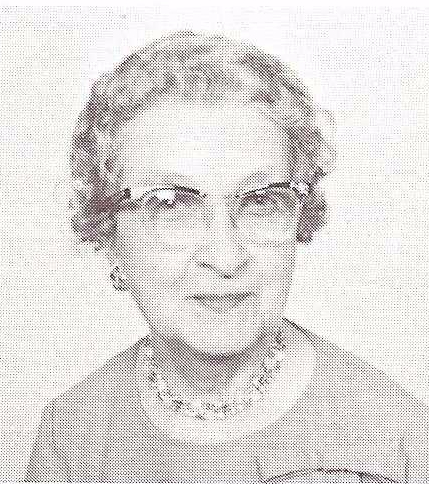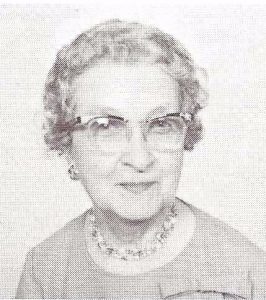
Monee Memories: Leola (Sonneborn) Emde
By Christi Holston

Leola Emde
I love Monee.
I am a lifelong resident of this community, and I can’t see myself ever living anywhere else!
Monee has seen me as an infant being baptized at St. Paul’s UCC church, and as a small child starting my first day of school in Mrs. Smit’s classroom in the “Old School” building. I loved walking “Up Town” to get a popsicle on hot summer days from Brockmiller’s general store, and looked forward to the day in July when the Firemen’s Park brought the carnival to town.
I took Piano Lessons from Mrs. Emde and wished I could play Little League baseball with the boys. My first job was at the Honk and Holler Drive in, and I learned to drive on Monee’s curb-less streets. I graduated from Crete-Monee and married the love of my life David Holston at St. Paul’s. My father, grandfather, great-grandfather and great-great grandfather called Monee home.
For better or for worse, I am Monee through and through!
There are many other folks who share some of the same memories of Monee that I do. Folks who were here in the “Good Old Days”, and many more people who have moved to town more recently in hopes of finding all of the good things a small town can give; namely a sense of community and neighbors who care.
Monee is a little town, and we are all striving to make it a good place to live and to call home.
The Monee Historical Society is a fairly recent addition to the cultural landscape of our town, and we hope to help bring that sense of community to all of our residents. The Historical Society grew out of a common purpose; to save the historic Monee Creamery Building.
The village is now 100% behind restoring the building as the centerpiece of its vision for the restoration of Firemen’s Park, and then the village as a whole so we, as a group, have shifted our purpose to include preservation of all of Monee’s history, though archive collection, historical documentation and community outreach.
In this new weekly column, we hope to bring back to mind some of the stories, pictures and memories of the Monee of days past.
We welcome contributions for anyone who might have stories, memories or photos to share. And we are always looking for new members of the historical society! We usually meet on the second Thursday of every month at the Monee community building at Firemen’s Park. (This month is an exception, we will meet on Thursday the 19th at 7pm, please join us!)
Now come along as we take a peek at the past!
Mrs. Emde gave piano lessons to countless children in the village. I took piano and so did all three of my sisters. We walked uptown to Mrs. Emde’s house, which is still standing next to the post office. Piano lessons were .15 per child per week (I think we got a discount because there were 4 of us!)
We each had a little spiral notebook and Mrs. Emde would write down our lessons for the week. When we came back the following week, if we did well on our assignments, we got a gold star. Once we had 5 gold stars, we got a double star and when you had 5 double stars you could pick out a composer card from the box she kept on a table near the piano. We really worked hard for those gold stars!
Mrs. Emde was not young when I started lessons in the 1960s and her hands were so crippled with arthritis that she could only move the first two fingers of her right hand and the others were frozen in a semi-fist position. Somehow she still managed to play the piano wonderfully and I always marveled at the talent she must have had in her youth.
Below is a transcription of an interview that was conducted back in about 1980.
Bob Hurst was pastor at St Paul’s. We believe it was probably he that must have spoken with Leola and made a cassette tape recording of her thoughts and memories. Rachel White of the historical committee came across the tape a couple of years ago when she was doing genealogy research at the church, and transcribed the conversation.
Were it not for Bob Hurst and Rachel White, this wonderful slice of history would be lost.
Transcription of Leona Sonneborn Emde’s cassette tape
I was confirmed in nineteen – three. I’ll try to relate what confirmation was like 77 years ago.
At that time, our church was called Deutsche Evangeliche Kirche: St. Paul’s Kirche, and was located in the northwest part of our cemetery. Right across the street, where our present church now stands was a small schoolhouse known as The German School. At the age 11 or 12, the children of our congregation would leave public school and attend the German School from October to Easter to prepare for their confirmation.
Most of us went for two terms. Rev Dorjahn was our minister at that time and he also served as our school teacher. It really was a German school. Everything was in the German language. We started by learning to write the alphabet. We had a German speller and a German arithmetic book. Of course, we had the German catechism, which we learned and had to commit from cover to cover. We also had the Bibleschichten? Which meant our Bible study and of course then, our bible
We also had to do translations.
Rev. Dorjahn would read a story in English and we would write it in German. Or, he would read it in German and we would write it in English.
The minister expected us to be in church every Sunday morning or bring an excuse, and it had better be a good one. We sat in the front benches; the boys on one side and the girls on the other. Monday morning he would question us about his sermon. Now remember, everything was in German. He wanted to see if we were really listening. We received credits for the things we remembered, and then at the end of month, the one who had the most credits would receive a pretty card. It really helped us to concentrate and remember what was said.
Confirmation was always on Palm Sunday. On Saturday, the class would decorate the church. We went to the people in town to ask for potted plants. Then we made wreaths from the leaves and were very happy and proud of our church on Palm Sunday morning. A few years previous to my confirmation the girls had to wear black dresses. But we were allowed to wear a white dress and the boys had to have black suits. Palm Sunday morning, we came down the aisle with Rev. Dorjahn. We were very nervous as we took our seats in the front row, and the church was filled with people. We didn’t know when he would call on us or what we would have to say.
He began with the catechism, and I think he went from cover to cover. Then questions from the old and the New Testament. Finally, the ordeal was over and we gave a great sigh of relief when he closed the book. We sang our class song and then knelt at the altar for the blessing.
Went back to German school during the week between Palm Sunday and Easter to prepare for our first communion on Easter Sunday. The girls were not allowed to wear their white dresses. We had to have a black dress for our communion, and the boys, of course, had their black suits. It was such a sad and solemn occasion, that most of us cried through the whole service.
I was fourteen when I was confirmed and there were 16 in my class. Four are still living. Albert Dralle and myself are still members of the same church as 77 years ago, which is now called St. Paul’s United Church of Christ.